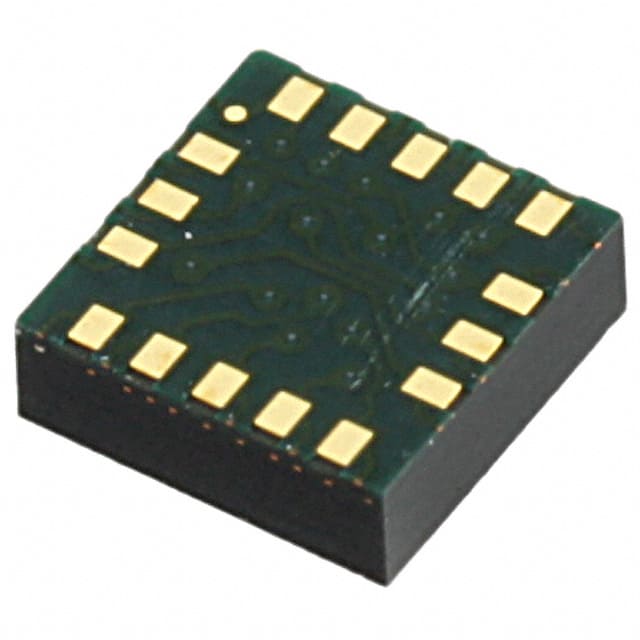Siehe Spezifikationen für Produktdetails.

H3LIS331DLTR
Product Overview
The H3LIS331DLTR belongs to the category of accelerometers and is commonly used in various applications such as motion sensing, vibration monitoring, and tilt detection. This sensor is known for its small size, low power consumption, and high performance, making it suitable for integration into various electronic devices. The H3LIS331DLTR is typically packaged in a small, surface-mount package and is available in different quantities to meet the needs of different applications.
Specifications
- Operating Voltage: 2.16V to 3.6V
- Sensitivity: 100mg/digit to 400mg/digit
- Output Data Rate: 0.5 Hz to 1 kHz
- Digital Output: I2C/SPI
- Temperature Range: -40°C to 85°C
- Package: 3x3x1mm plastic land grid array (LGA)
Detailed Pin Configuration
The H3LIS331DLTR typically features a standard pin configuration with pins for power supply, ground, communication interface (I2C/SPI), and interrupt outputs. The detailed pinout can be found in the product datasheet.
Functional Features
- High resolution and low noise
- Embedded temperature sensor
- Low power consumption
- Programmable interrupt generators
- Self-test capability
Advantages and Disadvantages
Advantages
- Small form factor
- Wide operating voltage range
- High sensitivity
- Low power consumption
Disadvantages
- Limited measurement range
- Sensitivity to external magnetic fields
Working Principles
The H3LIS331DLTR operates based on the principles of micro-electromechanical systems (MEMS) technology. It utilizes capacitive sensing elements to detect changes in acceleration along three axes. The sensor's internal circuitry processes these changes and provides digital output through the selected communication interface.
Detailed Application Field Plans
The H3LIS331DLTR finds extensive use in applications such as: - Mobile devices for screen orientation and gaming control - Industrial equipment for vibration monitoring and predictive maintenance - Wearable devices for activity tracking and gesture recognition - Automotive systems for airbag deployment and vehicle stability control
Detailed and Complete Alternative Models
Some alternative models to the H3LIS331DLTR include: - LIS3DH: A similar accelerometer with higher resolution and lower power consumption - ADXL345: An alternative accelerometer with a wider measurement range and robust digital output interface - MMA8452Q: Another option with low power consumption and flexible embedded functionality
In conclusion, the H3LIS331DLTR accelerometer offers a compact and efficient solution for motion sensing and tilt detection in various electronic applications. Its high performance, small form factor, and low power consumption make it a popular choice among designers and engineers seeking reliable motion sensing capabilities.
Word Count: 398
Listen Sie 10 häufige Fragen und Antworten im Zusammenhang mit der Anwendung von H3LIS331DLTR in technischen Lösungen auf
What is the H3LIS331DLTR accelerometer used for?
- The H3LIS331DLTR accelerometer is commonly used to measure acceleration in technical solutions, such as motion detection, tilt sensing, and vibration monitoring.
What is the operating voltage range of the H3LIS331DLTR?
- The operating voltage range of the H3LIS331DLTR is typically between 2.16V and 3.6V.
How can I interface with the H3LIS331DLTR accelerometer?
- The H3LIS331DLTR accelerometer can be interfaced with using standard digital interfaces such as I2C or SPI.
What is the measurement range of the H3LIS331DLTR?
- The H3LIS331DLTR has a selectable measurement range of ±100g, ±200g, or ±400g.
Can the H3LIS331DLTR be used for impact detection?
- Yes, the H3LIS331DLTR can be used for impact detection due to its high measurement range and sensitivity.
What are the typical applications of the H3LIS331DLTR in technical solutions?
- Typical applications include industrial equipment monitoring, automotive systems, gaming devices, and wearable devices.
Is the H3LIS331DLTR suitable for low-power applications?
- Yes, the H3LIS331DLTR features low power consumption, making it suitable for battery-powered or energy-efficient applications.
Does the H3LIS331DLTR have built-in self-test capabilities?
- Yes, the H3LIS331DLTR includes built-in self-test capabilities for diagnostic purposes.
What are the key features of the H3LIS331DLTR for technical solutions?
- Key features include high resolution, low noise, embedded temperature sensor, and programmable interrupt generators.
Are there any specific mounting considerations for the H3LIS331DLTR in technical solutions?
- It is important to mount the H3LIS331DLTR securely to minimize mechanical stress and ensure accurate measurements. Additionally, proper decoupling and filtering should be considered for optimal performance.

